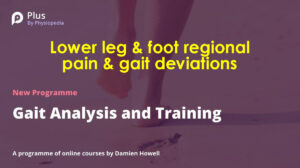Keeping the Spring in Your Step: Ankle Joint Power & Aging

http://bit.ly/DAMIEN25
As we amass more birthdays and get older we tend to walk/run slower, take shorter steps, and fewer per minute. Why do we seem to have less spring in our step the older we get? Kids move fast and crash elderly move slow and crash. One factor is kids have good ankle power elderly have diminished ankle power.
The muscles of the different joints in the lower extremity work together. They propel us forward. But studies show that the amount of propulsive power varies across the different joints of the lower extremity (hip, knee, and ankle). A normal distribution of propulsive power is the hip joint provides approximately 33%, knee 33%, and ankle 33%.
Age causes a redistribution of the joint powers. The elderly use hip joint muscles more than their ankle joint muscles compared to young, when walking at the same speed. Rough estimates are the elderly propulsive power is the hip joint provides approximately 74%, knee 13%, and ankle 12%.
Decrease in ankle propulsion and power during gait is thought to be major factor explaining the decline of walking and running in older age. The decrease in ankle propulsion with aging is correlated with the spinal stenosis, increased risk of Achilles rupture, Achilles tendon problems, osteoarthritis of hip joint, and falls
Why this redistribution of forces across the lower extremity occurs with aging is not fully understood and continues to be debated. It is thought that individuals lose muscle tissue as a natural process of aging. Additionally older individuals have shorter and more flexible calf muscles. More flexible or less stiff can be a bad thing like having a flat flexible bike tire. The calf muscles play a larger role in propelling forward. Older individuals walk near the maximum capacity of ankle muscles, whereas the knee and hip muscles operate a much lower relative level.
What does it look like when an older individual has less than ideal ankle power? A physical therapist can perform a slow motion video gait analysis and identify gait deviations associated with diminished ankle propulsion (prolonged heel contact, diminished vertical oscillation of center of mass). A physical therapist can also assist in performing an assessment to determine if there is normal ankle muscle strength as described in this article.
Intervention/Treatment:
Accordingly one would expect this loss of ankle joint strength in elderly could be counteracted with muscle strengthening exercises such as heel raise exercise, tip toe walking, hopping, and skipping drills. The results of research along this line of intervention are confusing. A study by C.M Beijersbergen showed older adults participating in aggressive ankle joint strengthening exercises was beneficial at improving ankle joint power only during fast running not when walking. This is consistent with the theory proposed by Irene Davis of the inability of strengthening exercises alone to alter observed gait deviations. She proposes a more thorough approach in addition to strengthening exercises is to incorporate gait training.
Gait Training Cues to Put More Spring in Your Step”
The image or verbal cue to alter gait deviation of diminished ankle joint power is walk with spring in your step.

Another image or verbal cue is walk and peer over the crowd or fence

Alternatively imagine using your feet to propel up and forward like using a skate board.

A potential side effect of consciously engaging your ankle joint when walking is others will comment “you are looking confident and happy, you look young”.
There are ways to avoid walking slow and crashing as we age. There are ways to keep spring in your step and to put more spring in your step.
A on demand-video webinar exploring this topic is available at Plus by Physiopedia entitled “Gait deviations associated with lower leg & foo pain syndromes”.
Use this code – “Damien30” for a 30% discount to access this webinar as well as the more than 500 continuing education webinar courses available at Plus by Physiopedia. This is the link http://bit.ly/DAMIEN30 with the 30% discount code embedded
Damien Howell Physical Therapy – 804-647-9499 – Fax: 866-879-8591 At-Home, At Office, At Fitness Facility – I come to you, I do home visits Damien@damienhowellpt.com
1 Comments
Leave a Comment
You must be logged in to post a comment.


[…] to physical therapist Damien Powell, PT, when a young adult goes for a brisk walk, the main joints in his or her body responsible for […]